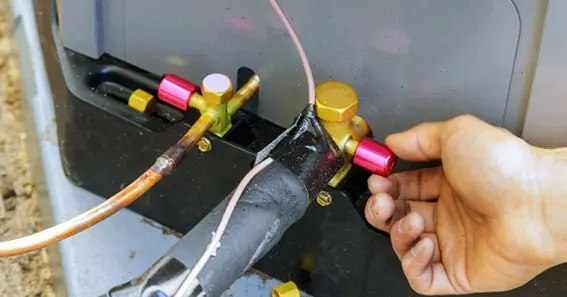An AC valve is a crucial component in air conditioning systems, serving as a gateway for refrigerant flow and providing access points for maintenance and diagnostics. Understanding the different types of AC valves and their functions can help ensure the efficient operation of your HVAC system.
Types of AC Valves
Various valves are utilized in HVAC systems, each serving specific purposes:
1. Service Valves
Service valves are integral to air conditioning units, allowing technicians to access the refrigerant circuit for tasks such as pressure measurement, refrigerant charging, and system isolation during maintenance. They typically have multiple positions to control the flow of refrigerant:
-
Front-Seated Position: Closes the valve, stopping refrigerant flow.
-
Back-Seated Position: Opens the valve fully, allowing normal refrigerant flow and isolating the service port.
-
Mid-Seated Position: Partially opens the valve, enabling access to the service port for diagnostics or charging.
Proper manipulation of service valves is essential for accurate system servicing and to prevent refrigerant leaks.
2. Schrader Valves
Similar to the air valves on car tires, Schrader valves are used in AC systems to provide access points for refrigerant charging and pressure checks. They consist of a threaded valve core with a pin and spring mechanism that allows refrigerant to enter when depressed. These valves are commonly found on both the high and low sides of the AC system.
3. Expansion Valves
Expansion valves regulate the flow of refrigerant into the evaporator, controlling the cooling effect. They come in two main types:
-
Internally Equalized Valves: Measure pressure at the valve’s inlet to regulate refrigerant flow.
-
Externally Equalized Valves: Measure pressure at the evaporator outlet, providing more accurate control in systems with significant pressure drops.
Proper functioning of expansion valves is vital for system efficiency and performance.
Importance of AC Valves in HVAC Systems
AC valves play a pivotal role in the operation and maintenance of HVAC systems:
-
System Maintenance: Valves like service and Schrader valves provide access points for technicians to perform diagnostics, pressure checks, and refrigerant charging.
-
Flow Regulation: Valves such as expansion valves control the amount of refrigerant entering the evaporator, directly impacting cooling efficiency.
-
Safety Measures: Properly functioning valves prevent refrigerant leaks and allow for safe isolation of system components during maintenance.
FAQ
1. What is the function of a service valve in an AC system?
A service valve allows HVAC technicians to access the refrigerant circuit for pressure measurements, charging, and system isolation during maintenance.
2. How does a Schrader valve work in an AC unit?
A Schrader valve provides a port for refrigerant charging and pressure checks, operating with a pin and spring mechanism that opens when a tool depresses the pin.
3. Why are expansion valves important in air conditioning systems?
Expansion valves regulate the flow of refrigerant into the evaporator, controlling the cooling effect and ensuring system efficiency.
4. Can a faulty AC valve affect system performance?
Yes, malfunctioning valves can lead to issues like refrigerant leaks, improper cooling, and increased system strain, reducing overall efficiency.
5. How often should AC valves be inspected?
It’s advisable to have AC valves checked during regular HVAC maintenance visits to ensure they are functioning correctly and to prevent potential issues.
Understanding the roles and types of AC valves is essential for maintaining an efficient and reliable air conditioning system. Regular inspections and proper handling during maintenance can prevent common issues and extend the lifespan of your HVAC system.










